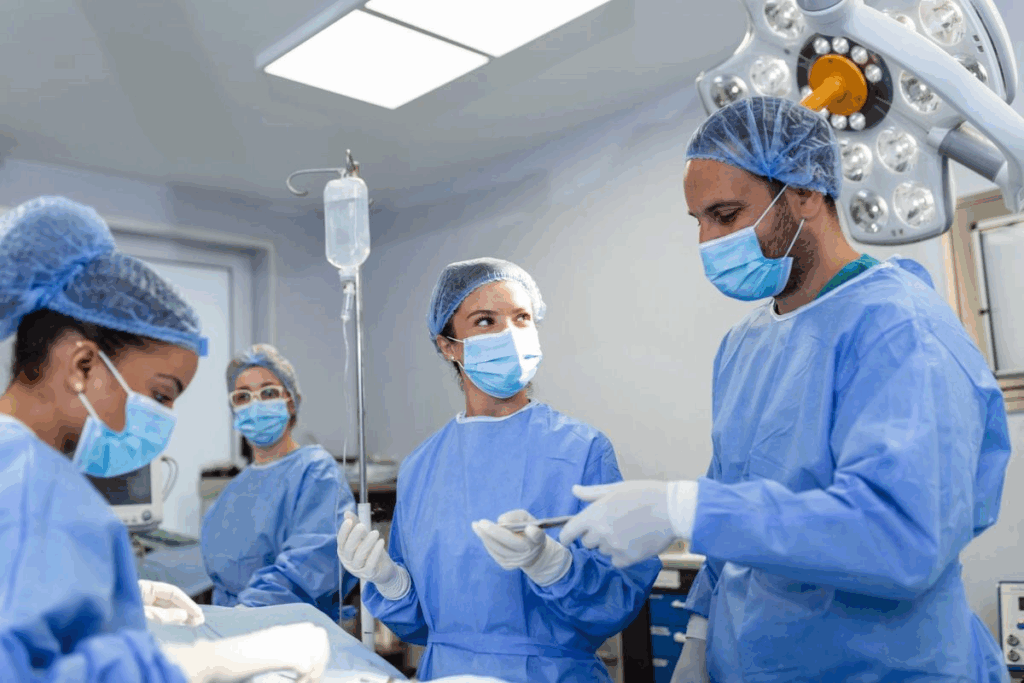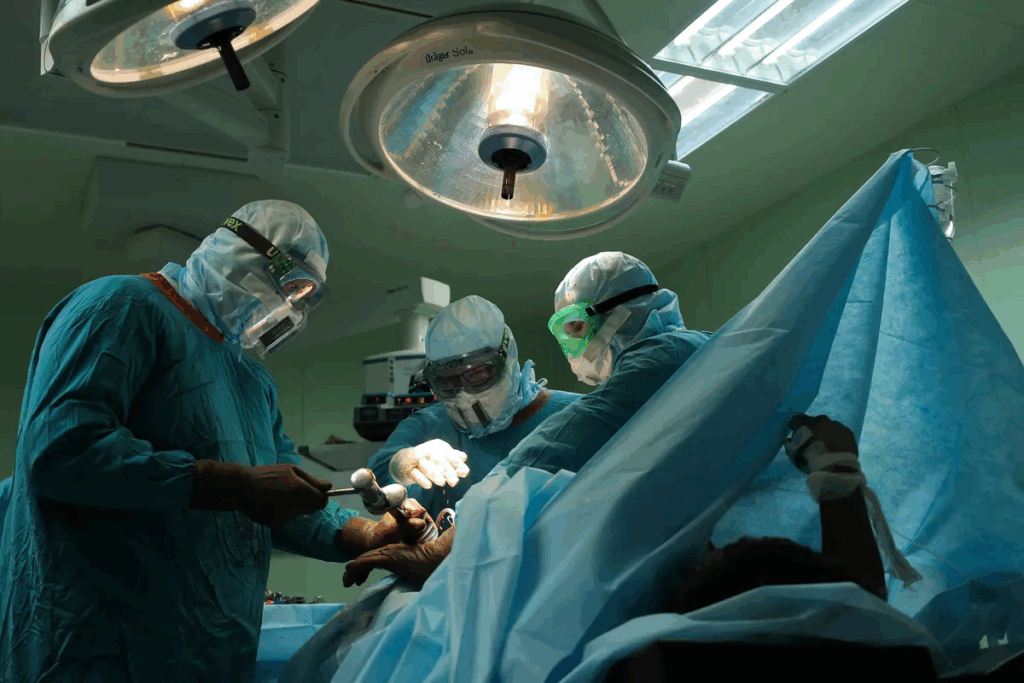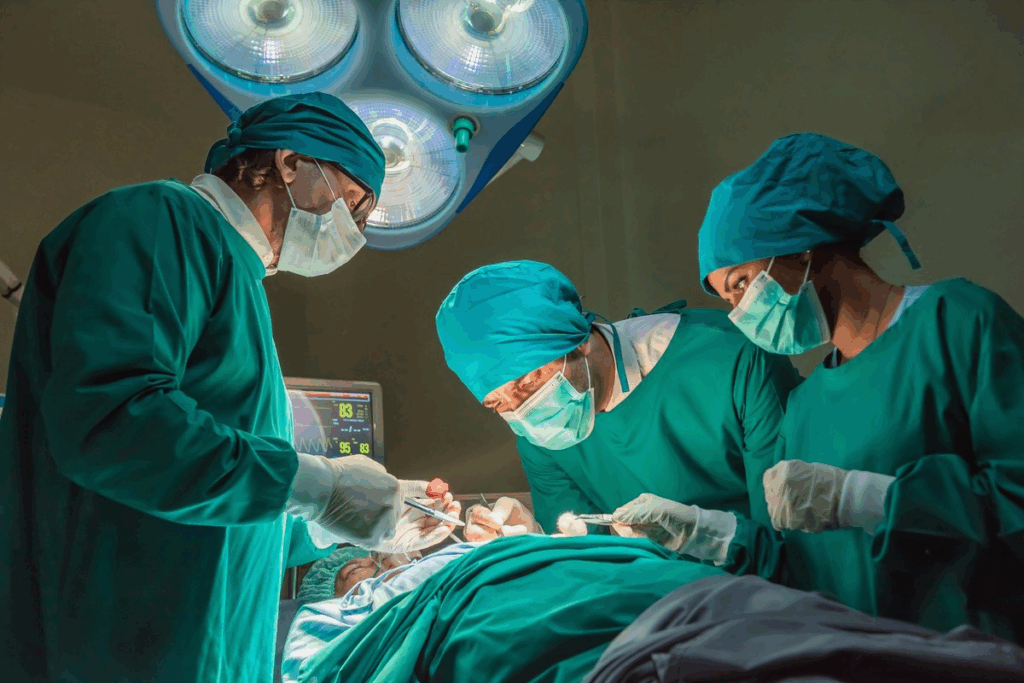Last Updated on October 30, 2025 by Bilal Hasdemir

Gallbladder surgery, also known as cholecystectomy, is done by a general surgeon. They often specialize in the stomach or laparoscopic surgery. The gallbladder is a pear-shaped organ below the liver. It stores bile, a digestive fluid made by the liver. Learn what kind of doctor does gallbladder surgery and when removal is recommended.
If the gallbladder gets sick or inflamed, it might need to be removed. Doctors usually suggest surgery when other treatments don’t work or if it’s a big health risk.
Liv Hospital is known for its top-notch care and international medical excellence. They offer expert advice on gallbladder health and surgery options.

It’s key to know about the gallbladder’s anatomy and function to understand its health role. This small, pear-shaped organ sits under the liver. It’s vital for our digestive system.
The gallbladder is about 3 to 4 inches long. It has three main parts: the fundus, body, and neck. It connects to the liver via the cystic duct.
This duct joins the common hepatic duct to form the common bile duct. This setup lets the gallbladder store and concentrate bile from the liver.
The gallbladder’s main job is to store bile. Bile is a liver-made fluid that breaks down fat during digestion. When fatty food hits the small intestine, the gallbladder releases bile.
This bile flows into the small intestine through the common bile duct. It helps break down fats for better absorption.
As “the gallbladder stores bile, a fluid made by the liver that helps break down fat during digestion”, it’s essential for digestion. The hormone cholecystokinin triggers bile release when we eat fatty foods.
“The gallbladder’s role in storing and releasing bile is key for fat digestion.”
To wrap it up, the gallbladder’s anatomy and function are vital for digestion. It helps break down and absorb fats, showing its importance for our nutrition.

Gallbladder removal, or cholecystectomy, is a surgery that needs a skilled doctor. General surgeons, often with training in gastrointestinal or laparoscopic surgery, perform this surgery.
General surgeons are the main doctors for gallbladder surgery. They can do both laparoscopic and open cholecystectomies. Their wide knowledge lets them handle many surgeries, including gallbladder ones.
Key Qualifications of a General Surgeon:
Some general surgeons specialize in gastrointestinal (GI) surgery, including cholecystectomy. These surgeons know a lot about the digestive system and are good at GI surgeries.
The benefits of choosing a GI specialist include:
| Specialty | Key Skills | Benefits for Patients |
| General Surgery | Broad surgical knowledge, laparoscopic skills | Comprehensive care for various surgical needs |
| Gastrointestinal Surgery | Advanced GI surgery techniques, knowledge of digestive diseases | Expertise in complex GI procedures, improved outcomes |
When looking for a surgeon for gallbladder surgery, check their qualifications, experience, and patient reviews. It’s important to feel comfortable asking about their credentials and success rates with cholecystectomies.
Choosing a qualified and experienced surgeon ensures the best results for your gallbladder surgery.
There are many ways to remove the gallbladder, each suited for different needs. The choice depends on the patient’s health, any complications, and the surgeon’s skills.
Laparoscopic cholecystectomy is the most common method. It involves small incisions in the abdomen. A laparoscope with a camera lets the surgeon see the gallbladder on a screen.
Benefits of this method include:
Open cholecystectomy uses a larger incision. It’s chosen when laparoscopic surgery is not possible.
Reasons for choosing open cholecystectomy include:
Single-incision laparoscopic surgery (SILS) uses one incision at the umbilicus. It aims to reduce scarring and postoperative pain.
Robotic-assisted cholecystectomy uses a robotic system. It offers high-definition visualization and precise control, improving outcomes in complex cases.
The advantages of robotic-assisted surgery include:
Many conditions can affect the gallbladder, sometimes leading to removal. The gallbladder is not essential for life but can cause health problems. Certain conditions can make it necessary to remove it.
Gallstones are a common reason for gallbladder removal. These stones form when bile hardens into a solid. They can cause pain and block the bile duct. Symptomatic gallstones need surgery to avoid complications like inflammation or infection.
“The presence of gallstones is a significant risk factor for gallbladder disease, and surgical removal is often the most effective treatment for symptomatic cases.”
Cholecystitis is inflammation of the gallbladder, which can be acute or chronic. Acute cholecystitis is often caused by gallstones blocking the cystic duct. This leads to severe pain and can be life-threatening if not treated quickly. Chronic cholecystitis results from recurring inflammation, potentially causing gallbladder dysfunction.
Chronic inflammation can cause scarring and thickening of the gallbladder wall. This impairs its function. In both cases, removing the gallbladder is often necessary to prevent further complications.
Gallbladder polyps are growths from the gallbladder lining. While many are benign, some can be malignant or have cancerous tendencies. The risk of malignancy depends on the polyp size and presence of other gallbladder diseases.
Gallstone pancreatitis happens when a gallstone blocks the pancreatic duct. This causes inflammation of the pancreas. It’s a serious complication of gallstone disease and needs immediate medical attention.
Gallstone pancreatitis is a significant reason for gallbladder removal to prevent recurrence. Surgery is often done after the acute pancreatitis has resolved.
When health issues affect the gallbladder, surgery might be needed. Cholecystectomy, or gallbladder surgery, is a common procedure. It helps alleviate symptoms and prevent complications from gallbladder diseases.
Symptomatic gallstones are a main reason for gallbladder surgery. Gallstones are small, hard deposits in the gallbladder. They cause symptoms like severe abdominal pain, nausea, and vomiting.
If gallstones block the bile duct, they can cause jaundice. This is when the skin and eyes turn yellow. Surgery is usually needed to remove the gallbladder and prevent more problems.
Persistent pain can also mean you need gallbladder surgery. Chronic inflammation of the gallbladder, or cholecystitis, causes recurring pain. If not treated, it can lead to serious issues like gangrene or perforation of the gallbladder.
Gallstones can also cause gallstone pancreatitis. This is when a stone blocks the pancreatic duct, causing inflammation of the pancreas. Surgery is often needed to fix these complications and prevent them from happening again.
A bile duct blockage is a serious issue caused by gallstones. It can lead to jaundice, infection, and even life-threatening problems if not treated quickly. Surgery to remove the gallbladder is often necessary to fix the blockage and restore bile flow.
In emergency cases like acute cholecystitis or gangrene of the gallbladder, surgery is urgent. These conditions are life-threatening and require immediate removal of the gallbladder to prevent severe complications or death.
Gallbladder surgery is a proven treatment for many gallbladder conditions. Knowing when it’s necessary helps patients make informed decisions about their care. Surgery can greatly improve the quality of life for those with gallbladder disease by addressing the root causes of symptoms and complications.
Many people wonder if they need to have their gallbladder removed. The answer depends on their health situation. Knowing when surgery isn’t needed can help them make better choices about their health.
If you have gallstones but don’t feel any symptoms, you might not need surgery. Some folks have gallstones without any problems. In these cases, doctors might suggest watching them instead of removing them right away.
Asymptomatic gallstones are often found during tests for other health issues. If these stones don’t cause trouble, you might not need surgery.
For mild gallbladder issues, there are other treatments before surgery. Doctors might prescribe medicines to break down gallstones or ease symptoms.
Some people might find relief through lifestyle changes, like changing their diet. A doctor will suggest the best treatment based on your condition.
A watchful waiting approach means keeping a close eye on your condition to see if surgery is needed. This is often suggested for those with asymptomatic gallstones or mild symptoms.
Regular doctor visits and tests help doctors see if your condition is getting worse or if symptoms are starting. This way, they can act quickly if surgery is needed.
Understanding your options can help you make informed decisions about your care. This way, you can avoid surgery when it’s not necessary.
Many people wonder if they can live without their gallbladder, mainly when surgery is an option. The gallbladder is seen as non-essential. Its removal doesn’t greatly affect one’s life.
After the gallbladder is gone, the body adjusts. Bile now flows straight from the liver to the small intestine. This change doesn’t slow down digestion much, as the liver keeps making bile for fat digestion.
Key Adaptations:
Adapting to life without a gallbladder involves several changes. At first, some might notice bowel movement changes or mild discomfort. But these symptoms usually go away.
Adaptation Process:
Not having a gallbladder doesn’t lead to long-term health problems for most. But, some might need to change their diet to help with digestion. Below is a table of possible dietary changes.
| Dietary Component | Pre-Surgery | Post-Surgery |
| Fat Intake | Normal fat diet | May require reduced fat intake initially |
| Fiber Intake | Normal fiber diet | May benefit from increased fiber |
| Meal Frequency | Regular meals | May benefit from smaller, more frequent meals |
In conclusion, the gallbladder is important for digestion but not for survival. The body adjusts well to its loss. Most people live normally without lasting health problems.
Getting ready for gallbladder surgery is important. You’ll need to do some key steps. These include pre-surgical checks, following a diet plan, and talking about your medicines with your doctor.
Before surgery, you’ll have to go through some tests. These help check your health and find any risks. You might have:
Before surgery, it’s good to follow a certain diet. This can help avoid problems. You should:
Talking to your surgeon about your medicines is also key. Some might need to be changed or stopped before surgery.
“Getting ready well is important for a good surgery and recovery. By listening to your surgeon and making the right changes, you can lower risks and have a smoother recovery.”
It’s important to ask your surgeon the right questions. Think about asking:
Being informed and ready can make your surgery and recovery better.
Learning about gallbladder surgery can ease worries for those facing it. This surgery, or cholecystectomy, removes the gallbladder. It’s a small organ under the liver.
The surgery is usually done laparoscopically. This means small cuts are made for a laparoscope and tools. Laparoscopic cholecystectomy is chosen for its less invasive approach, leading to faster healing.
The surgeon will carefully separate the gallbladder from the liver and bile duct. Then, they remove it through a small cut. Modern surgical technologies make the surgery more precise and safe.
General anesthesia is often used for gallbladder surgery. It makes sure the patient is asleep and pain-free during the surgery.
In some cases, other anesthesia options might be discussed. But general anesthesia is the usual choice for this surgery.
Gallbladder surgery usually lasts 1 to 2 hours. Most patients can go home the same day or after a night in the hospital.
How long you stay in the hospital depends on your health and if any complications happen during or after surgery.
The use of laparoscopic equipment and robotic-assisted surgery has greatly improved gallbladder surgery. These tools allow for more accurate operations with smaller cuts. This means less recovery time and less scarring.
Some places also use single-incision laparoscopic surgery. This method makes the surgery even less noticeable.
Recovering from gallbladder removal involves several steps. These include immediate care after surgery, changes in diet, and slowly getting back to normal activities. Knowing these steps is key for a smooth recovery and avoiding complications.
Right after surgery, patients go to the recovery room. There, doctors watch their vital signs and help with pain or discomfort. Following the surgeon’s instructions about rest, medication, and appointments is very important.
Even without a gallbladder, some lifestyle changes might be needed. This includes diet changes and managing symptoms like diarrhea that some people may experience after surgery.
Diet is very important during recovery. At first, a low-fat diet is suggested to help the digestive system. Later, patients can go back to a regular diet, but some might need to avoid high-fat foods to stay comfortable.
“A healthy diet rich in fruits, vegetables, and whole grains can help manage symptoms and support overall health post-surgery.”
How long it takes to get back to normal varies. Usually, people can start their usual activities in a few weeks. But, it’s important to listen to your body and not rush the healing process to avoid problems.
By understanding the recovery process and following the care instructions, patients can have a smoother transition to life after gallbladder removal.
It’s important for patients to know about the risks of gallbladder surgery. Cholecystectomy is usually safe, but knowing the possible side effects and complications is key.
Common side effects of gallbladder surgery include:
These side effects are usually mild and go away in a few days to weeks.
Though rare, serious complications can happen. These include:
It’s vital for patients to know about these risks. They should get medical help right away if they have severe symptoms.
Some patients get post-cholecystectomy syndrome (PCS) after gallbladder removal. Symptoms can include:
The exact cause of PCS is not always known. It’s thought to be linked to changes in bile flow and digestion after the gallbladder is gone.
If you have severe symptoms after gallbladder surgery, seek medical help right away. This includes:
Early treatment can greatly improve outcomes.
In summary, while gallbladder surgery is usually safe, knowing the risks helps patients make better choices about their care.
Understanding gallbladder health is key to making smart choices for your body. Knowing how the gallbladder works and when it might need to be removed helps. This knowledge lets patients manage their health better.
Gallbladder surgery is often needed for problems like gallstones or cholecystitis. A general surgeon or a specialist in the stomach and intestines usually does the surgery. The laparoscopic cholecystectomy method is popular because it leads to a faster recovery.
Deciding about gallbladder surgery means weighing the risks and benefits. It’s important to talk to your doctor about your options. They will consider your health and how bad your symptoms are.
Being well-informed about gallbladder health helps you take charge of your health. By staying up-to-date and talking to doctors, you can make the right choices. This ensures the best care for your gallbladder and improves your overall life quality.
No, you don’t need a gallbladder to survive. After it’s removed, your body can adjust. Digestion doesn’t really change.
You might need to remove your gallbladder if you have gallstones. This is also true for persistent pain, bile duct blockage, and emergencies like acute cholecystitis or gangrene.
Yes, removal is often needed for gallstones, inflammation, polyps, and tumors. These cause a lot of symptoms or problems.
General surgeons, often with a focus on the stomach and intestines, do gallbladder surgery.
Yes, most people can live normally without a gallbladder. Your body gets used to it. You might need to change your diet a bit, but your health won’t be badly affected.
Risks include pain and infection, which are common. But there are also rare but serious problems like bile duct injury or post-cholecystectomy syndrome.
To prepare, you’ll have pre-surgery checks, follow diet and medicine rules, and ask your surgeon questions. This helps you get ready.
The surgery removes your gallbladder, usually through a small incision, under anesthesia. How long it takes and how long you stay in the hospital depends on your case.
Recovery starts with care right after surgery. Then, you’ll make lifestyle changes and follow dietary advice. You’ll slowly get back to normal activities.
For mild cases or gallstones without symptoms, you might not need surgery right away. Other treatments or watching and waiting might be options.
Usually, no, you don’t need surgery for gallstones that don’t cause symptoms. But, it depends on your health and other factors.
Gallbladder removal is often needed for problems like gallstones, inflammation, or tumors. These issues can make life hard and affect your health.
Dahmiwal, T., et al. (2024). Dietary considerations in cholecystectomy. Journal of Gastrointestinal Surgery, 28(5), 345-350. Retrieved from https://pmc.ncbi.nlm.nih.gov/articles/PMC11200314
Subscribe to our e-newsletter to stay informed about the latest innovations in the world of health and exclusive offers!
WhatsApp us